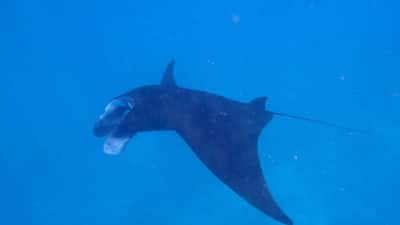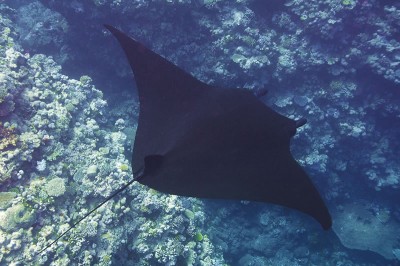Today we were conducting our ground-truthing operations in the beautiful lagoon of the Reef Islands in the Solomon Islands. The Reef Islands are a collection of remote islands and reefs located in the Santa Cruz group of islands, southeast of the capital, Honiara. Different from the others islands in the Santa Cruz group, which were formed volcanically, the Reef Islands were formed by a decrease in sea level, which exposed the tops of ancient coral reefs forming dry land. The reefs that remain submerged surround these islands, which are now dense with tropical vegetation, and home to various small villages. The remaining submerged reef extends west of the islands to form a large, protected, tropical lagoon.
While motoring slowly across the lagoon one day conducting our daily data collection, we encountered an unexpected visitor: a manta ray! We later found out from local residents that the lagoon of the Reef Islands is home to a family of manta rays.

Manta ray spotted in the Solomon Islands while conducting groundtruthing.
It was recently discovered in 2009 using genetic analysis that there are two species of manta rays: the giant manta ray and the reef manta ray. The giant manta ray is the largest type of ray in the world and is typically found roaming the deep open ocean, while making periodic visits to seamounts and coastal reefs. The reef manta ray tends to reside more in shallow coastal habitats such as the lagoon in which we were working. Mantas are found in the tropical and subtropical waters of the Atlantic, Pacific and Indian Oceans. The furthest they have been reported north of the equator is about 31 degrees north (i.e. location of North Carolina), and the furthest south of the equator they have been reported is 36 degrees south (i.e. north island of New Zealand). Reef mantas however limit themselves predominately to tropical areas.

Manta ray seen by researchers conducting research on the New Caledonia mission.
Mantas move using their elongated pectoral fins as wings, which they flap to drive water backwards (like a bird in the air). Manta rays are part of the elasmobranch sub-class together with sharks. Like sharks, manta rays give live birth to only one or occasionally two young after a gestation period of about 12 months. Once born, the pup resembles a miniature adult and is given its wings to fly on its own (i.e. not provided any additional parental care).
The greatest threat to manta rays is overfishing. Manta rays are fished both commercially and artisanally for their meat as well as for use in other products, such as their gills in Chinese medicine. Each year, thousands of mantas are commercially harvested solely for their gills, despite being listed as vulnerable by the International Union for the Conservation of Nature. Although some countries have established bans on manta fishing (such as the U.S., New Zealand, the Maldives and Indonesia), due to their migratory nature, mantas often travel through waters where regulations may not exist or be properly enforced. They are also often at risk to being caught in nets as bycatch.
Countries are now realizing the economic value of manta rays to attract tourism, and are deciding that manta rays are worth more alive than they are dead. This past year, Indonesia announced that mantra rays within its exclusive economic zone would be protected from fishing and export, citing a recent study which found that a manta ray is worth up to one million dollars in tourism revenue over the course of its lifetime, while only between 40 and 500 dollars if harvested. If properly enforced, conservation measures such as this are great news for this gentle giant.
Photos: 1 Steve Saul; 2 Ken Marks